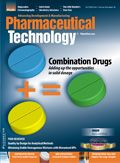Case Closed
Only the strong survive when it comes to pharmaceutical packaging and shipping.
Case by case
"We manufacture the same large volume parental product in two different factories; one in Europe and one in the US," explained our GMP Agent-In-Place. "They are filled into the same size bottle and sold around the world, sometimes in the same market. Each are packed into cases of 10 with crush zones around the edges. However, these zones make the case big and fewer fit onto a pallet. The European factory ships most of its product overseas, and so they wanted to minimize the number of pallets. For this reason, they designed the smallest possible case and used no crush zones. Both products are marketed in the same country, however, we had many complaints for breakage on the EU-manufactured product and almost none on the US-manufactured product. Now we either overpack the EU-made product, or replace the case with a more protective one. Someday we'll get the EU factory to start with a more protective case."
Forensics
"We found mold in our aseptic-filling rooms on a routine touch plate," complained our GMP Agent-In-Place. "This is a serious issue, because most cleaning and disinfection chemicals that we used do not kill mold. We immediately closed the room and quarantined the product that had been filled since the sample was taken. We then disinfected with a mold-killing agent, applied twice over two days, and then resampled. Only after a clean bill of health did we resume filling.
"We also needed to find the source. In a review of all the relevant data, we found the same mold on an employee's gown plate and on his glove touch plate. Following further sampling, we found more mold in the bulk tank staging room. The bulk tank had been stored for an abnormally long time in a cooler, and an employee noted that there was some condensation on it, which made it an excellent place for mold to grow. We found mold in the cooler as well, so we surmised that the mold grew in the cooler and the transport vector was the bulk tank exterior. The mold must have been transferred to the product hose, which is pushed through the opening from the bulk tank staging room into the fill room. The hose was disinfected in the fill room using ethyl alcohol, which doesn't typically kill mold typically. So the employee in the fill room transferred the mold around the fill room because it was on his hands from the hose.
We fully disinfected the cooler and bulk tank hold rooms. The two weeks' loss of use of the fill room could have been catastrophic if not for having sufficient capacity in two other fill rooms," our Agent concluded.
Guess which batch
"We got a telephone call from the Center for Biologics Evaluation and Research's lot-release branch," said our GMP Agent-In-Place. "They said they had received a container of unlabeled samples. Without a label, they could not tell which batch each sample came from, and therefore, could not test and release any of the batches that the container purported to hold. We had to replace the samples and chide the logistics staff, who were supposed to label them before shipping. It turned out that the regular logistics staff were on vacation, so it was a new-to-the-job person who did this and clearly didn't understand all the requirements."
All steamed up
"It started with a LAL (endotoxin) test failing for our clean steam system," our GMP Agent-In-Place grumbled. "The next day, the test passed, but then two days in a row failed. This intermittent LAL out-of-specification continued, and while it did, there were also intermittent total organic carbon and particulates failures. As part of the corrective action, we cleaned some condensate traps and found them to be full of junk, including many metal filings. This gave us a clue. There had been some piping replaced in the clean steam system and it had not been properly cleaned and passivated postinstallation. We lost a week of production, but finally got it cleaned up."
Pharmaceutical Technology's monthly "Agent-in-Place" column distills true-life cautionary tales from the files of Control, a senior compliance officer. If you have a story to share, please email it to Control at AgentinPlace@advanstar.com. We won't use any names, but if we do use your experience in the column, you'll receive a Pharmaceutical Technology t-shirt.

Prokaryotics Licenses Gram-Negative Antibiotic Potentiator from Northern Antibiotics
June 26th 2025Prokaryotics will gain worldwide rights to develop, manufacture, and commercialize NAB741, a non-bioactive polymyxin designed to increase permeability of the outer membrane of Gram-negative bacteria.